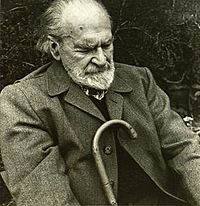Basil Bunting facts for kids
Quick facts for kids
Basil Bunting
|
|
|---|---|

Basil Bunting, in a photo taken by poet and photographer Jonathan Williams
|
|
| Born | Basil Cheesman Bunting 1 March 1900 Scotswood-on-Tyne, Northumberland, England, UK |
| Died | 17 April 1985 (aged 85) Hexham, Northumberland, England, UK |
| Resting place | Quaker graveyard at Brigflatts, Sedbergh, Cumbria, England |
| Occupation | Poet, military intelligence analyst, diplomat, journalist |
| Citizenship | British |
| Alma mater | London School of Economics (did not graduate) |
| Literary movement | Modernism |
| Notable works | "Briggflatts" (1966) |
| Spouse | Marian Culver (1930-1940) Sima Alladadian (1948-1979) |
| Children | 5 |
Basil Cheesman Bunting (born March 1, 1900 – died April 17, 1985) was an important British modernist poet. He became famous after his long poem Briggflatts was published in 1966. This poem is seen as one of the greatest achievements in modern English poetry. Basil Bunting loved music throughout his life. This made him focus on how poems sound. He believed it was very important to read poetry out loud. He was also very good at reading his own poems.
Contents
Life and Career of Basil Bunting
Basil Bunting was born into a Quaker family in Scotswood-on-Tyne. This town is near Newcastle upon Tyne. He went to two Quaker schools. From 1912 to 1916, he studied at Ackworth School. Then, from 1916 to 1918, he attended Leighton Park School.
Early Life and World War I
His Quaker education taught him to be a pacifist. This meant he was against war. During World War I, he refused to join the army. In 1918, he was arrested for being a conscientious objector. This is someone who refuses to fight in a war for moral or religious reasons. He was sent to prison for over a year. He was held in Wormwood Scrubs and Winchester prison.
After he was released in 1919, Basil Bunting moved to London. He started studying at the London School of Economics. There, he met many writers and social activists. He learned about the works of Ezra Pound, another famous poet. This meeting greatly influenced Bunting's own poetry.
Travels and Literary Connections
Basil Bunting left the London School of Economics without finishing his degree. He then traveled around Northern Europe. In 1923, he went to France. There, he became good friends with Ezra Pound. Pound even dedicated one of his books to Bunting years later.
Bunting also wrote articles and reviews for a magazine called The Outlook. He even became its music critic. His poetry started to show Pound's influence. He visited Pound in Italy and lived there with his family for a few years. His poems were published in important poetry magazines.
Later Life and Briggflatts
In the 1930s, Bunting became very interested in old Persian literature. He even learned some of the language. He started writing his own versions of Persian poems. The way these poems used sound patterns influenced his writing style. During World War II, Bunting worked for British Military Intelligence in Iran.
After the war, in 1948, he became a journalist. He worked as a correspondent for The Times of London in Iran. He later married a Kurdish woman named Sima Alladadian.
Basil Bunting returned to Newcastle. He worked as a journalist for the Evening Chronicle. In the 1960s, younger poets discovered his work. They were interested in the modernist style. This led to his "rediscovery." In 1966, he published his most important long poem, Briggflatts. The poem is named after a village in Cumbria. He is now buried in the Quaker graveyard there.
Basil Bunting once gave advice to young poets. He said, "I SUGGEST / 1. Compose aloud; poetry is a sound." He passed away in 1985 in Hexham, Northumberland. Today, Newcastle University gives out the Basil Bunting Poetry Award. It also has a Young Person's Prize for poets writing in English.
About Briggflatts
Briggflatts is a long poem divided into five parts. It is known for its complex use of sound. It also connects to old medieval literature. The poem is like an autobiography. It looks back at Bunting's teenage love and his time in the modernist poetry movement.
Briggflatts also makes readers think about life's limits. It celebrates the culture and language of Northumberland. It mentions historical figures like the Viking King Eric Bloodaxe. A famous critic, Cyril Connolly, praised the poem. He called it "the finest long poem to have been published in England since T. S. Eliot's Four Quartets."
Basil Bunting's Books
Here are some of the books Basil Bunting wrote or that contain his poems:
- 1930: Redimiculum Matellarum
- 1950: Poems (later revised as Loquitur in 1965)
- 1951: The Spoils
- 1965: First Book of Odes
- 1965: Ode II/2
- 1966: Briggflatts: An Autobiography
- 1967: Two Poems
- 1967: What the chairman Told Tom
- 1968: Collected Poems
- 1972: Version of Horace
- 1991: Uncollected Poems (published after his death)
- 1994: The Complete Poems (published after his death)
- 1999: Basil Bunting on Poetry (published after his death)
- 2000: Complete Poems (published after his death)
- 2009: Briggflatts (with audio CD and video DVD)
- 2012: Bunting's Persia (translations by Basil Bunting)
- 2016: The Poems of Basil Bunting (published after his death)
- 2022: Letters of Basil Bunting (selected and edited by Alex Niven)
See also
 In Spanish: Basil Bunting para niños
In Spanish: Basil Bunting para niños

